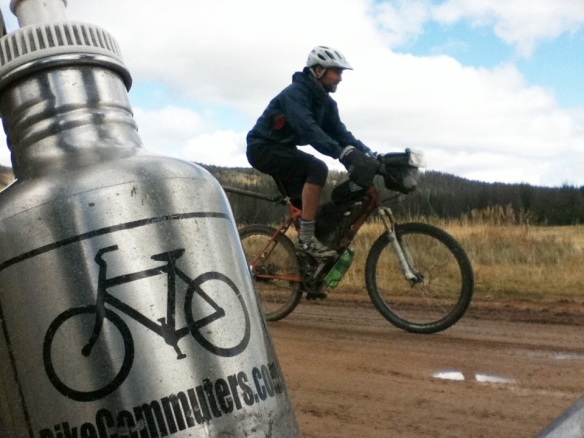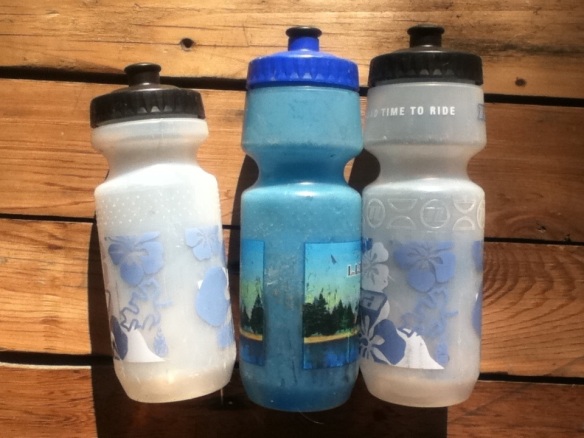Five and a third cans of Coke, a carton of milk, a growler of beer, or two and a half bottles of wine each make a half-gallon. This is also the liquid capacity of the typical touring bike carrying three plastic water bottles in three aluminum bottle cages. Years ago, in search of more water I ordered a 34 oz Zefal plastic bottle– the threads were poorly fit and the top leaked. I have used MSR Dromedary water bladders, but they can be cumbersome in use and can result in a high center of mass depending upon where they are carried. When using a framebag, a water bladder can be smartly stored inside the pack. Now, I prefer stainless steel Klean Kanteen bottles as they resist odors and flavors. There’s a new bottle in town and it leaves water tasting like water.

Leave Tang, or chocolate milk or malt liquor in a plastic bottle through an afternoon in Arizona heat and even with a few rinses, you’ll have a moldy bottle in no time. I now carry 40 oz. Klean Kanteen bottles in Profile Design Kages, whose plastic winged shape expands to fit the shape of larger bottles, including 1L glass bottles of Pellegrino and High Life, or a bottle of wine and baguette. It’s a bit of a stretch to fit the 40 oz. bottle, but with some use and a Kanteen full of hot water to mold the plastic to shape, the Kage complies.
A recent discovery: The Salsa Anything Cage fits the 64 oz. Klean Kanteen nicely, even with an insulating wrap in cold temperatures. It is designed to be a versatile cradle, to which various cylindrical or soft goods can be stowed.

In addition to safe drinking water, I can heat water in the Kanteen for tea, when my cookpot is indisposed, say, when I am eating oatmeal from it. Similarly, one can defrost a bottle over the stove, frozen by a cold night. Just don’t leave a full bottle out in the cold with it’s cap on. Unscrew the cap to prevent an explosive event.

The new 64 oz. Kleen Kanteen can replace or augment any touring system. For the bikepacking set, avoid storing water on the fork legs where it may affect handling. Replace the water capacity lost with the use of a framebag. An additional 2L bladder in the framebag and a 64 oz. Kanteen under the downtube– 4 liters total– is enough water for a full day’s ride, or for a dry camp overnight. Surely, extra bladders could be carried without penalty of weight or space. MSR Bladders are rugged, but the Nalgene-style top is bulky. Platypus bladders in 0.5, 1 and 2L sizes are cheap and fold into the corners of a pannier or framebag for later deployment.

Clean water stored in the capacious 64 oz Klean Kanteen is no heavier than “lightweight” plastic bottles. Consider the following:
The typical touring bike carries three plastic water bottles, each 24 oz.:
Salsa Nickless water bottle cage: 50 g x 3= 150g
Specialized 24 oz. water bottle: 85 g x 3=255g
M5 mounting bolts: 3 g x 6=18g
72 oz water: 2129 g
Total weight: 2552 g= 35.44g/oz.
A single stainless steel 64 oz. Klean Kanteen bottle with a Salsa anything cage:
Salsa Anything cage: 120 g with straps
Klean Kanteen 64 oz.: 11.625 ounces, 330 g
M5 mounting bolts (x3): 9 g
64 oz. water:1893 g
Total weight: 2352= 36.75 g/oz

Of course, if light weight is of great importance, a 2L soda bottle would suffice and is easily replacable at no cost. This is the approach many lightweight thru-hikers take, and it would lower the weight/volume ratio below that of multiple plastic bike bottles.
Klean Kanteen also makes bottles in 12, 18, 27, and 40 oz. capacities. The 40 or 64 oz bottles are certainly the way to go to reduce hardware weight and/or to carry fewer bottles. If only someone would make a dedicated bottle cage for the 40 oz bottle.
Issues:
Small frames such as Lael’s LHT do not accept large bottles under the downtube, and are further limited by tire and fender dimensions.
The width of the Anything Cage may interfere with chainrings when mounted low on the underside of the downtube. It is generally narrow enough to avoid the crank arms. It can be mounted at various heights using the three mounting holes, or using hose clamps.
The cage should be mounted flush against the frame, if possible. Mounting to one mounting bolt and using several hose clamps has the potential to create undue stresses on the cage. The ideal mount would be like those found on Salsa touring frames, designed for the three bolt pattern of the Anything Cage. All three holes are 64mm apart, designed to match the distance between normal bottle mounts. If using two bottle mounts and a single hose clamp, I suspect that spacing the cage away from the frame to meet the height of the frame braze-ons would reduce the chance of failure. Torsional forces endured while attached the fork of a bicycle are more likely to lead to failure. Forces under the downtube are almost exclusively in the vertical plane, and are less likely to force cages away from their mounts. In sum, beware when bolting or clamping items to the fork; both fatigue and snagging are possible.




